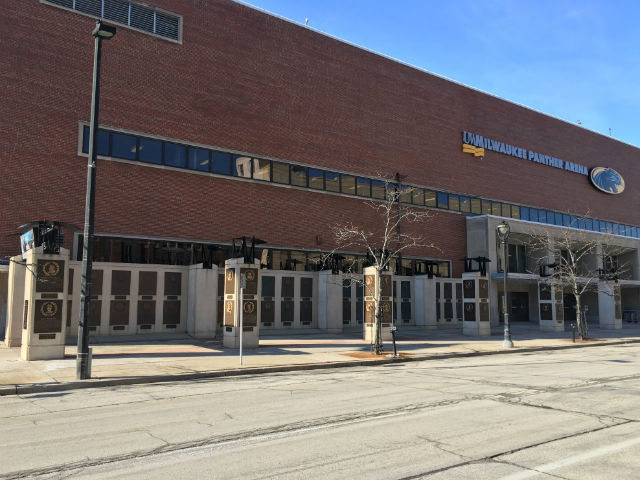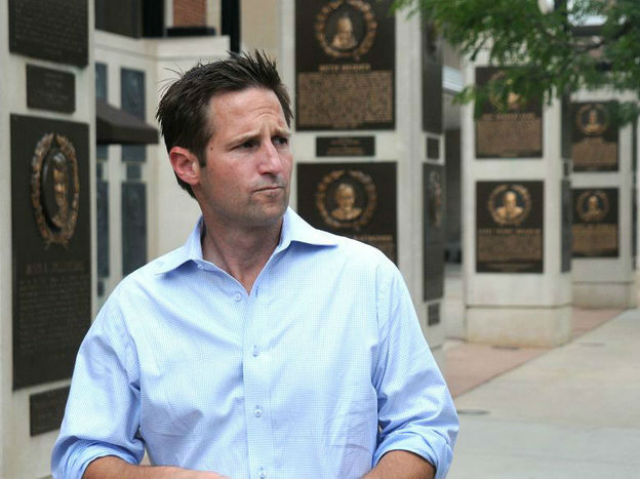On the day the recently resuscitated and suddenly quite vigorous Wisconsin Athletic Hall of Fame made its latest news – announcing Feb. 1 that it will celebrate the Green Bay Packers’ 1966 championship team at its upcoming induction – the winter afternoon sun, high in Milwaukee’s southwestern sky, shone down brilliantly on 4th Street, covering much of the promenade in shade and silhouetting the bronze-plaque visages that commemorate the state’s greatest sports heroes.
There’s an overly embellished metaphor somewhere in all of that – something about the heretofore-dormant Hall, once active and esteemed, casting a long shadow on its saviors, who are looking to return it to glory, or at least relevance – and if it’s embellished enough, it might approach the grandiloquence of sportswriters from half a century ago, and perhaps even Joseph Krueger might have deemed it worthy.
Krueger was the dramatic, booming-voiced founder of the Hall of Fame. He ran the thing as his labor of love and, according to those that were close to him, would be turning over in his grave if he knew what it had endured: not one, but two extended periods of latency, the second ending a little more than a year ago.
Since Krueger created it back in 1951, through his three decades of tireless work making inductions some of the city’s most prominent events, through his death in 1987 and, subsequently, through more than a quarter-century of ownership uncertainty and instability, until today, 65 years later, the Wisconsin Athletic Hall of Fame has honored 135 distinguished members, including Hank Aaron, Vince Lombardi, Oscar Robertson and Bart Starr, among a multitude of others, and it’s memorialized them all in bronze on the downtown Walk of Fame.
A long shadow, indeed.
And now, the person stepping out of it is Brian Lammi, president of the eponymous sports management company in Milwaukee, who’s hoping to leverage his enthusiasm and professional expertise to inject new life into the old institution. He promises to be dedicated and do things differently, striving not only to preserve the Wisconsin Athletic Hall of Fame – which currently consists of the burnished faces and plaques, plus some spare artifacts and surviving materials – but also to improve, expand and bring it into the modern age. Perhaps even build an actual museum, which would be a good thing, because the promenade is running out of room.

But before considering Lammi’s plans for the future, fans must understand the Hall’s illustrious-yet-ignored past. And no one understands that better than Gregg Hoffmann.
Rich history
A longtime Wisconsin journalist and author who’s now semi-retired to the warmer climes of the American southwest, Hoffmann is the institutional memory of the Hall of Fame.
Intimately involved with it for decades, he attended inductions as a young fan from Kenosha, covered them later as a hustling freelancer, spent countless hours at Krueger’s home poring over "reams of information," spearheaded endeavors to rekindle the Hall when it fell on hard times after Krueger’s death and, eventually, helped introduce and connect Lammi through his "Revive the Hall" campaign.
Now in his 60s, Hoffmann is compiling the Hall’s history and inductee bios into a book, which, though it would be his seventh, is the one he’s wanted to publish for years. Hoffmann is boundlessly eager to talk about where the Hall is finally going, calling it a potential "golden age." But first he has to tell you about where it’s been – we’ll call that the bronze age.
In 1951, the Milwaukee Arena had just been built downtown, a $5 million modern facility for sports and entertainment that needed a tenant. Krueger, a sports aficionado and the city treasurer, had an idea. And, as was his habit, Hoffmann says, Krueger worked fanatically to make it a reality, trying to convince the state government to charter the Wisconsin Hall of Fame and compelling others to join the cause.
In April of that year, Walter V. Johnston, president of the powerful Milwaukee Auditorium Board, asked the governor to support the Hall and appointed Krueger its selection committee chairman in an exalted letter that reflected the eloquence of the times.
"The Auditorium Board, having this in mind, believes the new Milwaukee Arena is the site best suited for this worthy purpose," Johnston wrote. "They feel that the Wisconsin citizens would deem it a privilege to pay tribute to the sons and daughters of the Badger State who have brought fame and glory to Wisconsin, because of their achievements in the field of athletic endeavor.
"National shrines have acclaimed some in the past – others will be honored in the future. We feel that our proposed Hall of Fame will exemplify an ever burning torch for clean sports. It should always urge the unborn youth of tomorrow to achieve a high place in the presence of immortals we do honor, inasmuch as every youth is a hero worshipper, and the athletic star of the past is the guiding light of the present."
Soon after that, the State Senate approved the site and officially designated the Wisconsin Athletic Hall of Fame. In its resolution, the body mandated, "there be hung on its walls suitable bronze plaques honoring the athletic endeavors of Wisconsin’s men and women as an inspiration to the youth of our great state and the ever glorious leadership which the Badger State holds in athletic achievements."
Delighted at the accomplishment, Krueger immediately set to work. The first inauguration, on Nov. 28 of 1951, was a magnificent event, with 13 athletes honored (from baseball, football, boxing, bowling, wrestling and the Olympics), dozens of politicians and journalists invited to attend and hundreds of fans watching and cheering. State newspaper editors called the Hall a "very excellent" idea.

Lammi Sports Management
And for the next 35 years, with Krueger in charge, it continued to be one. There were regular ceremonies every other year that attracted thousands to events around the city (in 1974, the Milwaukee Arena became the MECCA Arena, which took over as the Hall’s governing body).
At the inductions, Hoffmann vividly remembers, Krieger would stand under a spotlight with a microphone and, in his deep baritone, declare that "It has come time to immortalize them in bronze!" Curly Lambeau, Warren Spahn, Elroy "Crazy Legs" Hirsch and many, many other athletes and coaches who played in or were from Wisconsin were honored, and their plaques hung inside the arena.
Hoffmann also remembers sitting in Krueger’s Bay View home every Friday starting in the late 1970s, the old city treasurer and the young cub reporter united by a love of sports, talking and reading together and turning their weekly visits into a close friendship.
Krueger "ran it as his baby," Hoffmann says, until his death from cancer created a leadership void for the Hall.
"When Joe died, and this can happen when somebody is kind of covetous of something and does a very good job with it," Hoffmann says, "there was nobody else at the MECCA who really knew or even – between you, me and the fence posts – really cared that much about it. So it just went dormant."
Hard times
From 1987 until 1993, local politics and personalities clashed and there were no new inductions, which was a violation of the Hall’s charter requiring new members be added every two years. Kenosha Senator Joe Andrea and Milwaukee Sentinel sports columnist Bud Lea, with urging from Hoffmann, prodded the state government and the MECCA Board to renew Hall enshrinements, especially with the Bradley Center opening in 1988 down the street, drawing the major indoor sporting events away from the old Arena,
"I actually kind of spearheaded an attempt," says Hoffmann. "I'd send a letter to the guy who ran the MECCA every year and I would say ‘poor Joe Krieger must be turning over in his grave,’ and basically say when are you guys going to do something?"
Those efforts led to some minor activity, but it wasn’t until five years later that a new entity swooped in to truly – if temporarily – rescue the Hall. The Wisconsin Sports Authority, an organization of local supporters that was started by Joe Sweeney and counted a young Brian Lammi as one of its interns (OnMilwaukee's Jeff Sherman also worked for Sweeney at the Sports Authority), purchased all the assets from MECCA in 1993 and held inductions, including a star-studded 1995 class that comprised Robin Yount, Oscar Robertson, Al McGuire, Dan Jansen and Bonnie Blair. It was hosted by Bob Costas.
In 1998 and '99 ceremonies, under the Sports Authority, the Hall added Sidney Moncrief, Paul Molitor, Jan Doleshcal, Bob Uecker and several others.
"That group did a great job," Hoffmann says. "They did not miss an induction and they had some good inductions with good people going in."
But, as he points out, "you don’t make a lot of money running the Hall of Fame."
When the Sports Authority, which helped bring notable events to Milwaukee like the Frozen Four, began to suffer financially – particularly following the breakup of the famed Cheese League of NFL teams that held their preseason camps in Wisconsin – well, "you don’t save the lifeboat when the ship is going down," Hoffmann says.
Shortly thereafter, though, in 1999, another organization stepped up. The Wisconsin Sports Development Corporation, a nonprofit in Madison, took over ownership and ran the Hall for a decade, holding biennial inductions and, in 2001, constructing the impressive Walk of Fame as part of the 50th anniversary celebration. Located outside the original Milwaukee Arena (later called the MECCA, at the time known as U.S. Cellular Arena and now named the UW-Milwaukee Panther Arena), the Walk was an outdoor promenade along 4th Street that permanently displayed the exhibit of bronze plaques.

The WSDC embraced the internet, held regular ceremonies at different venues every two years from 2001 through 2009 and introduced new initiatives, such as letting fans vote for inductees, which resulted in former Packer Fuzzy Thurston being enshrined in 2003. Executive director Ron Vincent made sure the Hall suited the organization’s mission of promoting health and fitness across the state and, in turn, sought to uphold its chartered duty of being an "inspiration to youth."
But, 10 years later, when revenue streams dried up, particularly those from the Department of Tourism and the Badger State Games, Hoffmann says, the organization couldn’t support the hall and eventually it dissolved completely.
For the second time since Krueger’s death, the Hall would lay dormant for six years.
"The Sports Authority and the Sports Development Corporation, I don't want to come off as ripping them because I think they tried their absolute best," Hoffmann says. "But it was harder as a not-for-profit, with very barebones staff, and not to really quite have the background and expertise in promotion, which is ultimately what hurt them."
New hope
After the WSDC disbanded, a group called the Wisconsin Sports Legacy Group, of which Hoffmann was a leader, started the "Revive the Hall" campaign to "keep the flame flickering," he says.
"It was a bunch of old jock-sniffers, guys who loved and covered sports, and we were trying to see if we could get anybody to buy it and run it," Hoffmann says. The group gave tours of the Walk, offered lunches at Major Goolsby’s across the street, published stories and made other efforts in the community.
It was through "Revive the Hall" that Hoffmann met Lammi, who told him how he’d once been a Wisconsin Sports Authority intern and would look at the Walk of Fame plaques and think more should be done with the history. The two recognized they shared a passion – "great minds think alike," Hoffmann says – and Lammi started making some calls to reach out and inquire about the Hall’s rights.
Though the process was "unfortunately not that easy," Lammi says, his company, Lammi Sports Management, was able to purchase the assets of the Wisconsin Athletic Hall of Fame in mid-December of 2014. The marketing-savvy president worked hard to show the Hall’s supporters "where our value could lie" and to convince them that his company was well-positioned to lead the rejuvenation.
 (PHOTO: David Bernacchi)
(PHOTO: David Bernacchi)
"We are already working on events and interacting with athletes, so we thought there could be a quality fit," he says. "We’re out there in the marketplace every day interacting with PR stories, with athletes and with sponsors on other projects, so it seems like we're having some of those same conversations that we need to have to make sure the Hall of Fame is moving forward."
Lammi’s acquisition – his salvaging – of the Hall was praised by politicians such as Gov. Scott Walker and Mayor Tom Barrett and enshrined athletes like Junior Bridgeman and Jerry Kramer. Hoffmann, especially, is thrilled with the new ownership, which will be managed by Wisconsin Hall of Fame LLC.
"The thing that I’ve always thought the Hall needed was better promotion," Hoffmann says. "And that’s why I think it’s got its best shot at getting there in all the years that I've been dealing with it, because of what Brian does and what his organization does. His main thing is marketing – with his clients, with the events he puts on – and that's what I always thought was needed."
Hoffmann says that while the Hall was "just kind of an add-on" for previous organizations that ran it, he believes Lammi looks at it as a priority, and one about which he’s passionate. Hoffmann says another problem in the past was the Hall, even when it was technically active, would be quiet for many months on end, only occasionally resurfacing for induction events or to ask sponsors for cash.
He believes Lammi will do a better job giving the institution exposure.
"It needs someone to keep it in the public eye during that time between inductions, and I know that he buys into that," Hoffmann says. "This thing isn't going to make anybody a lot of money, but it's got to be more publicly known – you can't just leave it sit for a year or a year and a half."
Lammi, who has fond memories of attending Hall of Fame events, says he’s committed to keeping it front-of-mind for sports fans. He’s "adamant" about holding inductions every year, more often than the original Senate mandate, and says "we’re looking forward to having more consistency on a regular basis."
He wants to have a charitable run-walk for the Hall and eventually build an entire weekend of events, similar to what the Pro Football Hall of Fame does every year in Canton, Ohio. And Hoffmann wonders if enshrined members, especially the ones that are from Wisconsin, could travel around the state to give speeches and talk to booster groups, raising awareness and funds.
Since he’s already entrenched in the sports management and marketing industry, Lammi has forged relationships with enthusiastic local partners like Cramer-Krasselt, an advertising and PR firm that’s helping him develop a new logo and concepting.
"It's absolutely a rebrand," Lammi says of the Hall. "It's a matter of keeping the tradition and the history and these iconic names, but telling that story in a more compelling, impactful way.
"We’re not looking to change the mission or the tradition or these great stories that comprise the Hall of Fame, but we think we can package it in a more consistent, coherent way, which makes sense because we plan on having a strategy for the next 30 to 50 years."
Lammi sees "a world of opportunities" and says the Hall "absolutely" has to become more than an outdoor promenade. He hopes, eventually, it will have a permanent indoor home, maybe a museum, and his group has already begun brainstorming with the Wisconsin Center District and other entities to explore new ways to offer a "tactile, integrated experience" for visitors.
"It’s already a good way for fans to be able to come and, for free, look at some of this great history and experience the Wisconsin Athletic Hall of Fame," he says. "But down the road, we certainly want to see how we can find a way to incorporate more technology and more experiential ways to be a part of that history.
"We need the Hall of Fame to be more accessible and more interesting to people of all ages and all walks of life."
Active hall
In the near term, Lammi and Hoffmann are happy just to renew regular inductions. The first one, on April 30 at the UW-Milwaukee Panther Arena (the original, if nominally different venue), will enshrine former Packers wide receiver Donald Driver and longtime Badgers basketball head coach Bo Ryan in the 65th anniversary class.
Lammi says it was a "more streamlined process" of selection this time, in order to "jumpstart the Hall of Fame and get it energized again." He says in the future there will be a committee, including legends like Bud Selig and Barry Alvarez, and a more formal process of nomination starting in 2017. He also hopes to implement fan voting in some capacity.
But for now he’s very satisfied with the two newest members chosen.

Ryan, who coached Wisconsin for more than 14 years, retired in December as the program’s all-time winningest coach. A four-time Big Ten Coach of the Year, he steered the school to 14 straight NCAA Tournament appearances and reached the national championship game in 2015.
Driver retired in 2012 after 14 NFL seasons, all spent in Green Bay. He was a four-time Pro Bowler and a Super Bowl champion, and the Packers’ career leader in receptions and yards. A fan favorite with a gigawatt smile, Driver says he was "shocked" when told of his induction to the Wisconsin Hall of Fame, but considers it one of his greatest honors.
"I played my entire professional career here and I feel like I've been ingrained in the state of Wisconsin," Driver says. "I have to take my hat off to the fans that made it all possible, because that's who makes your legacy either stand or fall, and they have allowed my legacy to stand now forever."
Driver’s rags-to-riches story of overcoming poverty and homelessness as a child in Houston to being a seventh-round NFL draft pick out of tiny Alcorn State University to becoming one of the greatest Packers of all time is one that exemplifies the Hall of Fame’s chartered mission of serving as an "inspiration to youth."
He says he hopes having his name, face and story preserved in downtown Milwaukee will motivate and encourage kids both in the city and across the state.
"We’re role models to so many different people, and I think that's where I have to understand more than anyone else, you're no better than the next person," he says. "The fans are the ones that put you on the pedestal."
Driver says he’s not sure what to expect when he’s enshrined ("we talk about the calm before the storm; right now I'm calm and happy, but the storm will come"), though he calls it "very special" to be part of the Wisconsin Athletic Hall of Fame’s Class of 2016.
As the date approaches, Lammi is making sure the first induction in nine years is a big event. The University of Wisconsin marching band will be there, he says, and the Hall will recognize the state’s male and female high school athletes of the year, too. And, of course, there was the recent announcement that the Packers’ 1966 team will be honored, with Kramer accepting the Legendary Team Award.
After riding out the winter in Las Cruces, N.M., and then Spring Training in Scottsdale, Ariz. – where he still writes the "Brewers Gameday" program – Hoffmann plans to be back in Milwaukee at the end of April for the ceremony. Virtually no one knows more about the Hall or has supported it longer, and Hoffmann is excited to once again see athletic heroes "immortalized in bronze."
Following that, he hopes the Hall of Fame will become part of the fabric of the city; he believes it aligns with Milwaukee’s drive to enhance its downtown. The Hall may not, on its own, draw out-of-state visitors, but if a father and son are already in town for a Brewers or Bucks game, he says, "I think that it could become a secondary tourist attraction."
Ultimately, Hoffmann wants to see a small museum featuring the collections of Krueger and other sports historians. He also thinks it would be fitting to extend the Walk of Fame – perhaps continuing it right into the forthcoming sports and entertainment district proposed by the Bucks, who, he notes, don’t yet have their own team hall of fame.
"I really want to help this thing move into the future," Hoffmann says, "and the timing is just so perfect with what the Bucks want to do downtown."
For his part, Lammi says he’s met with the NBA franchise "about potential partnerships," as well as other local teams, museums and organizations that believe the Hall is "an important piece of the Milwaukee sports and entertainment landscape." He’s excited about "the prospect of a revitalized 4th Street" and believes the Walk of Fame can add value to the area.
Hoffmann has seen a successful Hall, and he’s seen a neglected Hall. He’s optimistic it’s in good hands now and feels like the best is yet to come.
At least Joe Krueger won't be turning over in his grave anymore.
"When you're a city that's right now looking to promote itself and looking for economic development, the ‘we are open for business’ type of rhetoric," Hoffmann says, "why leave out something that already existed and has at least some potential for attraction? Why let it fade away? That seems kind of dumb to me and it always did.
"Granted, you have to keep it up and you have to promote it differently than it was before, but I still think it's a little bit of a gem that hasn't been completely polished yet. And I still think there's potential with it."
Born in Milwaukee but a product of Shorewood High School (go ‘Hounds!) and Northwestern University (go ‘Cats!), Jimmy never knew the schoolboy bliss of cheering for a winning football, basketball or baseball team. So he ditched being a fan in order to cover sports professionally - occasionally objectively, always passionately. He's lived in Chicago, New York and Dallas, but now resides again in his beloved Brew City and is an ardent attacker of the notorious Milwaukee Inferiority Complex.
After interning at print publications like Birds and Blooms (official motto: "America's #1 backyard birding and gardening magazine!"), Sports Illustrated (unofficial motto: "Subscribe and save up to 90% off the cover price!") and The Dallas Morning News (a newspaper!), Jimmy worked for web outlets like CBSSports.com, where he was a Packers beat reporter, and FOX Sports Wisconsin, where he managed digital content. He's a proponent and frequent user of em dashes, parenthetical asides, descriptive appositives and, really, anything that makes his sentences longer and more needlessly complex.
Jimmy appreciates references to late '90s Brewers and Bucks players and is the curator of the unofficial John Jaha Hall of Fame. He also enjoys running, biking and soccer, but isn't too annoying about them. He writes about sports - both mainstream and unconventional - and non-sports, including history, music, food, art and even golf (just kidding!), and welcomes reader suggestions for off-the-beaten-path story ideas.







